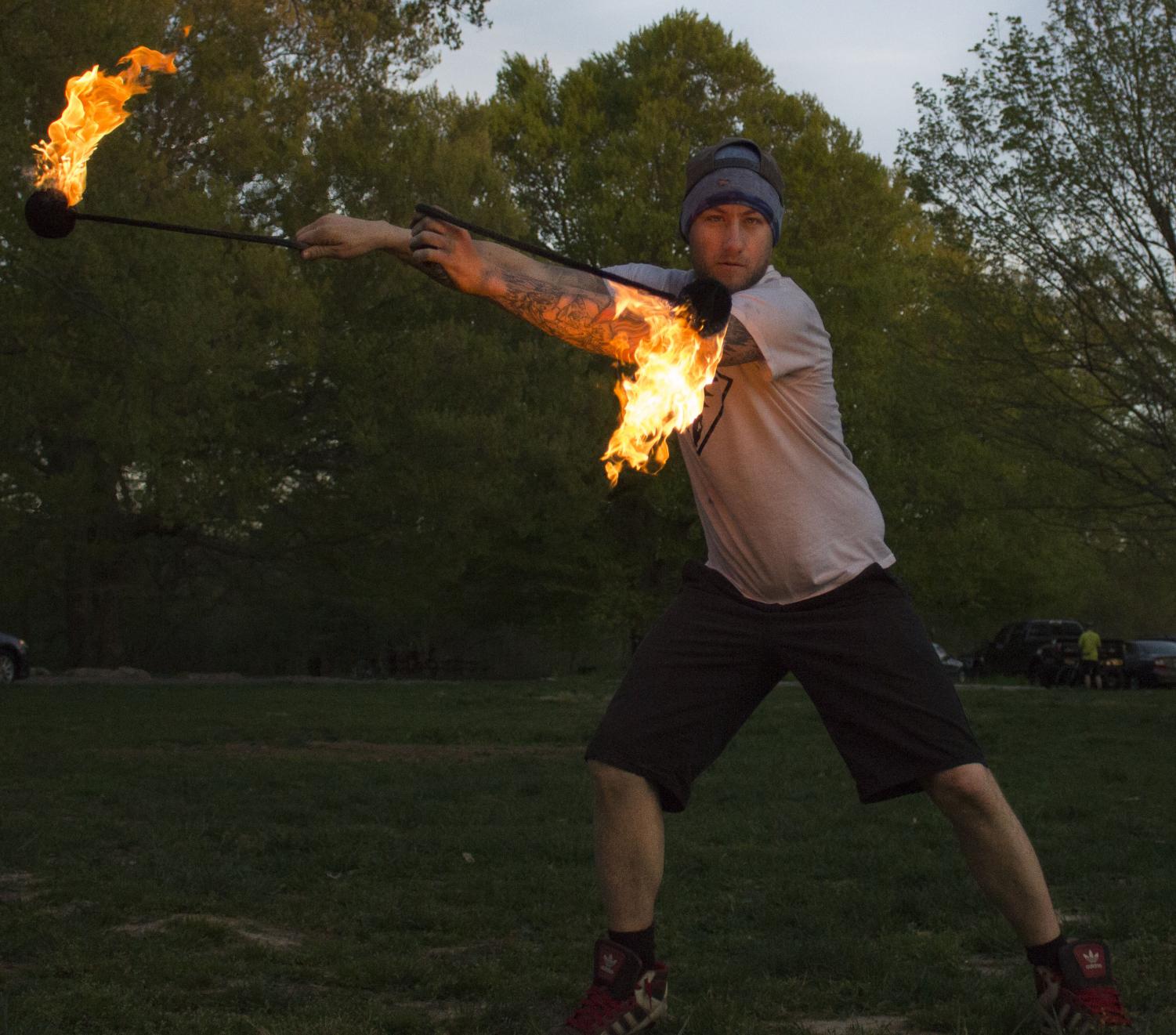Flow and play in Louisville’s flow art family
A look inside the history and people of Louisville’s flow art community
September 3, 2019
Down by the waterfront, off River Road in Louisville, adults and teenagers alike can be found dancing around with hula hoops, staffs and other objects that might look like circus instruments if you’re not familiar with the flow arts.
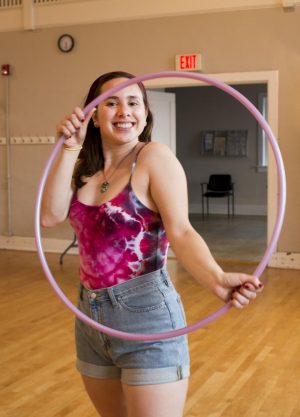
Intertwined between the worlds of vaudeville and burlesque, flow arts can be defined as the intersection of movement-based disciplines like dance, juggling, fire-spinning and object manipulation. Louisville’s flow art community has grown rapidly ever since a small group of people came together and started playing with their flow instruments in the summer of 2006.
Although, before the term “flow art,” flowing was known as a form of adult play.
History of Flow
Flow arts started as a psychological concept in the early 1990s. Psychologist Mihaly Csikszentmihalyi, author of multiple books detailing the many aspects of the flow arts, including “Flow: The Psychology of Optimal Experience,” coined the term and and described the highly focused mental state that flowing involves.
Holly Harvest, a veteran flow artist and instructor in Louisville, said she applied Csikszentmihalyi’s teachings in her approach to flowing.
“I took a lot from [Csikszentmihalyi’s] notes to create my class,” she said. “It’s really just exploring muscle memory and how memory affects muscles.”
Harvest and her husband run a business called Bourbon Town Burlesque, which performs regularly at Mercury Ballroom in Louisville. Apart from her business, she is also a hula hooping instructor at Suspend Louisville. The studio is mostly an aerial arts studio, but she leads one of the few ground classes.
“I think one thing that’s different that started an interest in flow arts and an interest in more movement things is [our generation] realized that it’s okay to be an adult and still play,” Harvest said. “Use our bodies and create more synapses that have to do with physical movement.”
Music festival culture has brought the flow arts into popularity in the more recent years, leading the once-underground culture of flowing into the spotlight, according to Harvest.
“[The band] String Cheese Incident is credited for getting the hoop going again,” she said. “They used to throw hula hoops out into their crowd and people started picking them up. That’s the legend on how it started. That was probably like 14 years ago.”
Giving a clear timeline of the flow arts is tricky because in several of the cases, the history of the art wasn’t written down. It was passed down either orally or done face-to-face, so there aren’t many references to back it up. Flow arts have placed prop manipulation from many different cultures and backgrounds into a new context, so it’s also difficult to sort out the history of the props from the history of the art itself.
As for Marcus Perry, veteran juggler and a founder of the Kentuckiana Jugglers, the flow community became its own community as a subculture within juggling.
“Actually, poi spinning can be traced back to club spinning — you take juggling clubs and you spin them around and do different things with them,” Perry said.
Perry’s introduction to juggling — before there was a definite flow community in Louisville — was through a hacky sack group called the Kiwi Kickers who met at Seneca Park when he was a kid.
“I used to go [to Seneca Park] every Sunday with my dad. My dad wanted to give up smoking, so he started juggling. That way he would have something to do with his hands besides hold a cigarette,” Perry said. “That was about 1986, and I learned to juggle with him.”
Each flow artist’s introduction to flow arts is a bit different than the next, but they all seem to have one thing in common — seeing someone flowing for the first time and wanting to pick up an instrument on their own.
According to Perry, he started to notice the Louisville flow community come together in the early to mid 2000s.
Although, for Harvest, flow arts started in 2006 when she met a small group of people in Louisville who called themselves The Phoenix Collective.
“They were the only ones doing anything remotely and that’s just because they went to Burning Man before anyone else did,” Harvest said.
Louisville’s Flow Beginnings
Poi flags are the first prop Harvest found interest in. These are weighted pieces of fabric that are used to spin around just like regular poi — which are weighted balls attached to string. When holding and spinning poi flags in a certain way, patterns can be created.
“When I was 18-years-old I found myself hanging out with a bunch of people in the rave culture. Poi was really big in there because they were doing the flow strings,” Harvest said. “Honestly, I found it a little weird at the time. I used to make a joke at them like, ‘Oh yeah, we’re all in a room staring at each other. Dance, monkey, dance!’”
Quickly after picking up poi flags, Harvest found an interest in fire.
“[My friends and I] met a fire breather, and at that point a few of us had picked up different manipulation toys. He’s the one who got us pointed in the right direction of what equipment to buy to start with fire eating,” Harvest said. “Through that, we started going to Cherokee Park every Tuesday just us — like 10 friends.”
The small group that went to Cherokee Park for flow sessions with Harvest grew into a field of people. Cherokee Park flow jams became a party.
Dana Michelle, a hula hoop instructor and member of the Louisville flow community, attests to Harvest being one of the reasons why the flow community flourished in Louisville. She’s known Harvest for years and gives her most of the credit for why she started flowing.
“When [flow jams] used to be here [in Cherokee Park], they would have a drum circle and people would come spin fire,” Michelle said. “Most recently Matt O’Daniel took that over.”
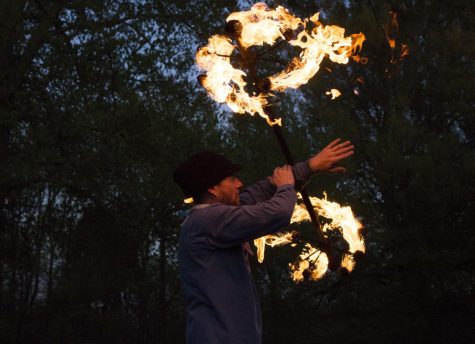
O’Daniel was a key ingredient to the Louisville flow family. According to Michelle, he was Louisville’s “flow daddy.”
Recently, O’Daniel passed away and the flow community has continued his legacy of pushing themselves further with their flow skills, and keeping his memory alive with lit candles at Unity of Louisville during flow jams.
“There was a guy spinning poi in amazing new ways in the late 2000s. In addition to him being really good at spinning poi, he was really good at actually getting people together to do it together,” Perry said of O’Daniel. “He was the one who did the early organizing of flow jam.”
With the efforts of Harvest and friends, O’Daniel, and others, the Louisville flow community started gathering together every week in what is now often referred to as Louisville Flow Jam (LFJ).
Louisville Flow Jam
Flow jams are held at Unity of Louisville on Thursday evenings starting around 6 p.m. and ending when the last flow instrument drops. The energy every person brings — young and old — is contagious.
Each artist in in their own element during these group flow sessions, yet they simultaneously feed off of each other’s movements and style. On one side of the room, there might be someone throwing a hula hoop in the air, while on the other side of the room, there might be someone twirling a levitation wand around their body or a contact staff rolling across their chest.
A levitation wand is a mystifying prop for flow that creates an illusion of a wand twirling around the users body. The wand is attached by a specific string that is manipulated around the body.
Contact staffs involve moves done using your torso, rather than just your hands, to manipulate the prop. There are multiple kinds of staffs including the dragon staff, which can have a wick added to one or both ends to be lit on fire.
Each person who attends LFJ brings their own spice to the magical recipe that is flow arts. Those who don’t practice with flow instruments are welcome to sessions with open arms regardless. Some join LFJ to do yoga, socialize, or simply dance around and enjoy the music and company.
Sarah Hakey joined the Louisville flow art community when she moved from Massachusetts. She learned about flow arts by stumbling across the different forms on Instagram and figured she would try out hooping to keep herself occupied.
“I don’t know what or where I would be without hooping. It has done so much for me,” Hakey said. “I was still pregnant with my daughter, Violet, and needed to connect with people, and was feeling down. I heard about flow jam through a bigger flow art group, and I was not hesitant to join because I knew it was an open-minded place.”
As a more recent member of the flow community, Sydney Hancock began dabbling in hula hooping during the spring of 2017.
Hancock was added to the LFJ Facebook page by a friend and immediately decided to join the group at Unity of Louisville.
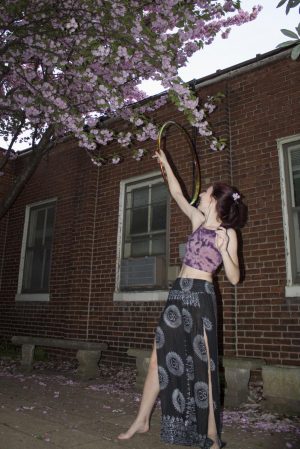
Photo by Mac Aubrey
“At first, I would mosey on around and admire other people. If I saw something that looked like it was in my realm I would ask someone if they could help me learn that,” Hancock said.
According to Hancock, when you walk into LFJ on Thursday evenings with a prop or no prop, you’re guaranteed a good time with good people.
“It’s a good space to always look forward to,” Hancock said.
Psychological and Physical Benefits
Flowing isn’t only an escape from reality but a form of healing and meditation. According to Harvest, Perry, Hancock, Hakey, and Michelle, flow arts have positively impacted their psychological and physical well beings.
According to Csikszentmihalyi, flowing has physical and psychological benefits that have been a therapeutic escape for those who choose to live this lifestyle — seemingly an introspective adult playground.
Allowing your body to take over and giving your mind a break has benefits on it’s own, according to Hancock.
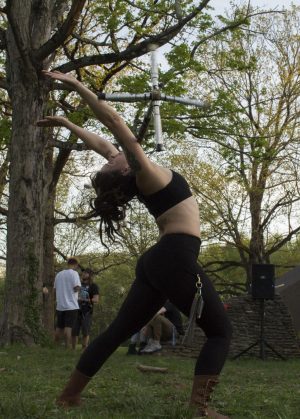
Photo by Mac Aubrey
“The psychological definition of flow is the act of moving at the same time as you’re thinking,” Harvest said. “The state of flow is when you make the connection between thought and movement to where you’re moving; it’s when your mind and body go together.”
The state of flow is similar to driving home but not remembering the drive, Harvest says. It’s when you do something over and over again until you don’t have to think about it anymore.
“There’s this part of our brain that once we’ve done something for so long, it actually logs onto a different section of our brain to where it becomes basically a habit,” Harvest said. “It’s like drilling something and having discipline to where you don’t need discipline anymore to do it.”
If attempting to learn a new trick in flow arts, Harvest says, you’ll do it over and over again, but mess up over and over again.
“You let it go, you pick it up, and all of a sudden you can do it,” Harvest said.
On a physical aspect, Harvest said she catches stuff better now. Ever since she emerged into this lifestyle, she’s become quicker and better on her feet. More specifically, it’s her form of meditation.
“Mentally it’s carried over into everything,” Harvest said. “My thoughts are clear.”
In his almost 40 years of flowing, Perry has also developed better coordination and balance. In addition, he’s certain of the mental and emotional benefits juggling has given him.
“Anything that calls you into presence, grounds you in reality. The flow arts tend to be difficult enough that they take your mind off of everything else,” Perry said.
By learning to juggle in his teens, and having divorced parents, juggling was Perry’s escape. Although, it was an escape to be grounded.
“Being fully with reality really helps. Participating instead of escaping reality helps you understand it better,” Perry said. “How gravity works, how physics works … it really puts you in touch with the material world.”
As for emotional benefits, Perry said that performing any type of movement always makes a person feel good, as well as releases tension or stress from the body.
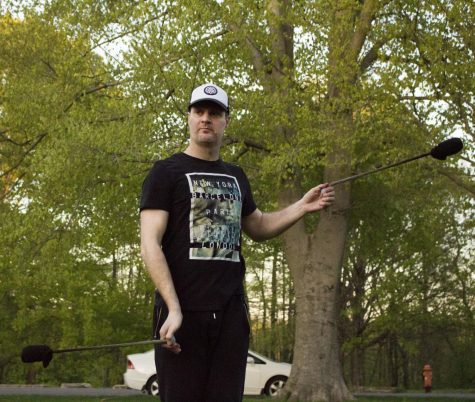
Photo by Mac Aubrey
“One of the neat things about flow is that, as a male growing up in America, it’s a good excuse for men to move. We don’t have a lot of excuses to move around and having these props kind of gives us permission to explore grace and movement and rhythm,” Perry said.
Hakey’s pregnancy was accompanied by flow arts. She hula hooped through her entire pregnancy, including labor. She said it helped her stay in shape, stay active, and stay in a positive state of mind.
Most importantly to her pregnancy, it helped her body naturally dilate. After Hakey had her first child, she had postpartum depression. Hooping was her only escape.
“Last summer I actually taught a workshop at a [movement and arts] festival called PlayThink about hula hooping through pregnancy and postpartum depression. It was called ‘Flowing into Parenthood,’” Hakey said.
Psychological and physical benefits are just two of the positive effects that stem from flow arts. Another benefit is the family that comes along with the lifestyle.
Flow Family
Perry said flowing has benefited him in many ways for nearly four decades, but the long lasting friendships that have been made along the way have made the most impact.
“Lots of my major friend groups are connected to these arts in one way or another,” Perry said.
While at the International Jugglers Festival in Fort Wayne, Indiana, Perry will be with a group of adults ranging in age from their 30s through their 60s. However, regardless of their age, he says they’re there because they still find benefits and have passion for the lifestyle.
“Still playing, still finding joy in movement and being present and still exploring what can be done with these things,” Perry said. “It’s an amazing place, and there’s no other place like it. I keep looking for a community that resembles it.”
According to Hakey, regardless of familiar faces or new faces, the flow community welcomes anyone with open arms.
“There are so many different types of people that flow. You will literally encounter so many different kinds of people that it will open your eyes in different ways. It is a wholesome community to be a part of. I sometimes need to take a step back and focus on myself, but there will always be friends that will tell me to hoop it out,” Hakey said.
Hancock said between the helpful tips on tricks, music suggestions, and sharing of flow props and fire fuel, the flow community is much more than just a space for people to unleash their inner illusionist.
“Flow jam for me is the community. It’s the space. It’s the family,” Hancock said.
